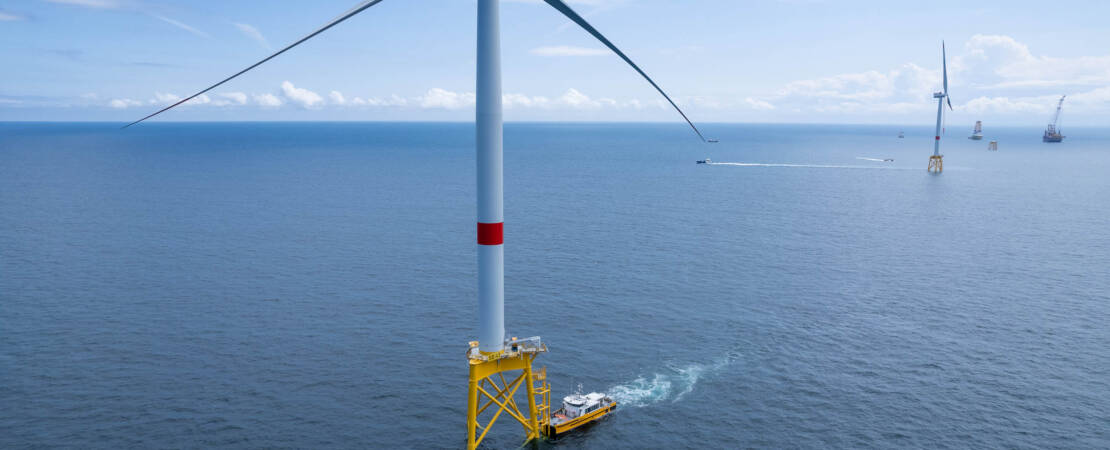All 62 of the 8 MW turbines at the Ailes Marines wind farm in the Bay of Saint-Brieuc, Brittany, are now grid-connected, eleven years after this gigantic project was first launched. Iberdrola has thus fully commissioned Brittany’s first offshore wind farm, which is expected to generate 1,820 GWh of green electricity per year, equating to the annual consumption of 835,000 inhabitants. This clean energy is projected to represent 9% of the region’s total electricity consumption. Let’s rewind and recap on this industrial feat.
In 2012, Iberdrola France won the French government’s tender for the construction of an offshore wind farm in the Bay of Saint-Brieuc. After obtaining the environmental authorisation in 2017, the French subsidiary of this leading Spanish energy firm launched construction on 3 May 2021, through Ailes Marines a special purpose entity 100 % owned by the Iberdrola group.
On 4 July 2022, installation of the first jacket foundations began, half of which were built in Brest. A few days later, the offshore substation was lifted into place at the centre of the wind farm. This impressive operation, implemented by Eiffage Métal and Engie Solutions, consisted in installing the foundation (63 m high, 1,630 tonnes) and the topside (55 m long, 31 m wide, 23 m high, 3,400 tonnes).
The 8 MW turbines, manufactured by the Siemens Gamesa factory in Le Havre, were transported and installed by Fred. Olsen Windcarrier’s (FOWIC) jack-up vessel Brave Tern, between May and December 2023. They are the most powerful turbines to be installed in France to date and are composed of a 90 m mast supported on the jacket foundation, a nacelle and three 81.40 m-long blades attached to the rotor. Each turbine has a total height of 209 metres.

On 5 July 2023, one of the turbines began to generate its first clean power, which was fed into the national grid by RTE, France’s transmission system operator.
The farm was then commissioned in tranches to reach a total capacity of 496 MW for an expected 25-year lifetime. The commissioning process involved two aspects:
- Technical commissioning: all the components, whether in the turbine, the blades or the substation, are checked, double-checked, trialled, stress-tested, fatigue-tested, re-booted, shut down…
- Commissioning in tranches to feed power into the grid: a first 20% tranche was signed off in late 2023, a second 50% tranche in the following weeks, to now reach 100%. The farm’s expected maximum capacity is 496 MW.
The landfall point is located at the Doberie onshore substation, near Erquy. From there, RTE manages the distribution of electricity.
Once it has been launched, the generation of offshore renewable energy will remain constant throughout the projected 25 years of operation.
Strong involvement of the region’s companies
The construction and installation of the Ailes Marines wind farm generated between 1,700 and 1,800 jobs in France, including more than 500 in Brittany, particularly at the ORE terminal in Brest. Iberdrola’s contractor Navantia-Windar subcontracted the manufacture of some of the jacket foundations to over 15 Brest-based companies. This alone represented nearly 300 full-time equivalents for 3 years.
Another contractor opened a new plant in Brest’s port area for this project: the Basque Haizea Wind Group, specialised in the manufacture of wind turbine masts. “The group opened a new plant on Brest’s polder and created Haizea Breizh, with 40 new jobs for 2 years. Here they fitted the mast sections with electronic equipment, safety ladders and platforms, before transferring them to Le Havre to be assembled.” explained Stéphane Alain Riou, Offshore Director at Iberdrola France. This has proved to be a lasting endeavour, with two other offshore projects (Noirmoutier and Le Tréport) set to go into production in Brest in 2025 and 2026.
In total, 144 regional micro-enterprises, SMEs and intermediate-sized enterprises have been supporting the project since its development phase, supplying the necessary manpower, equipment and services for the various project activities. “The numerous environmental studies and monitoring programmes were also carried out by Breton laboratories and consultancies. There was a lot of innovation in this field and some patents were even filed for new monitoring methods invented. This will earn them recognition for these methods when bidding to work on other wind power projects around the world. Several local environmental associations also worked on the project.”
To prepare for the active maintenance phase, new permanent structures have also been built. “In Saint-Quay-Portrieux, a pontoon will be used for maintenance vessels on a daily basis. Our maintenance building will be located in the neighbouring town of Binic and will house around 80 full-time workers, during the 25-year operating phase. Maintenance and electricity production will be managed remotely from there. These two sites will become the farm’s onshore hub, featuring the only facilities of their kind in the Côtes-d’Armor.”
Finally, the benefits for tourism are also visible. Last summer, the boat operator Vedettes de Bréhat started up boat tours of the wind farm. Nearly 4,000 visitors seized this opportunity to discover the first wind turbines.
To find out more: read the full article

